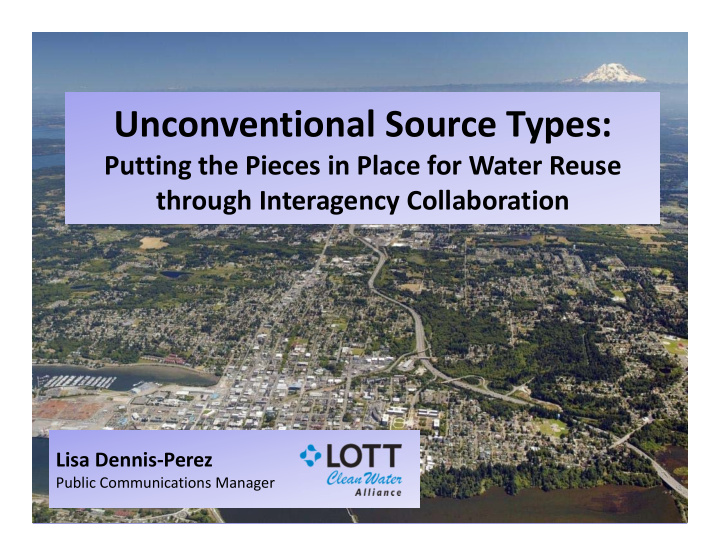



Unconventional Source Types: Putting the Pieces in Place for Water Reuse through Interagency Collaboration Lisa Dennis ‐ Perez Public Communications Manager
Mission: Preserve and protect public health and the environment by cleaning and restoring water resources for our communities
Budd Inlet Treatment Plant
Wastewater Resource Management Plan Four part approach: • Flow Reduction • Increased Wintertime Discharge • Reclaimed Water • Groundwater Recharge
Producing Reclaimed Water
Budd Inlet Reclaimed Water Plant
Martin Way Reclaimed Water Plant
Establishing Policy Infrastructure “once we produce the water, then what?”
Policy Questions • Who owns/ has rights to the water? • How far does LOTT’s responsibility go? • Can responsibility be transferred? • Who will purvey the water? • How will water be shared among partners? • How much will reclaimed water infrastructure cost? Who pays? • And more!
Policy Basics • LOTT serves as the “wholesaler” • City water utilities serve as the “retailer” • LOTT’s permit responsibility remain to end use • Legal agreements secure shared responsibility • Water is allocated to partners based on their relative flow contributions • LOTT provides “trunk” lines between LOTT uses • Cities are responsible for distribution to customers
Policy Framework State Level Regional Partners City Level State General Supply Ordinances Reclaimed Interlocal Agreements Water Agreement Permit Distribution Model End User Agreement End User Agreements Agreement
Putting Reclaimed Water to Use
Pipelines to Tumwater and West Olympia
Heritage & Marathon Parks
Percival Landing
Port of Olympia
LOTT Regional Services Center
Hands On Children’s Museum and East Bay Public Plaza
Future Uses
Future Uses
Hawks Prairie Reclaimed Water Ponds and Recharge Basins
Hawks Prairie Reclaimed Water Ponds and Recharge Basins
Gaining Public Acceptance
East Bay Public Plaza and WET Science Center
Planning for the Future Hawks Prairie Budd Inlet TP Reclaimed Martin Way RWP Water Treatment and Mullen Road Tumwater RWP RWP Recharge Sites East Mullen Henderson Rixie Rd Legend RW production site GW recharge site South Deschutes UGA boundary
Regulatory Uncertainties & Watershed Management Issues • Deschutes River/Capitol Lake/Budd Inlet TMDL • State Reclaimed Water Rule development • Thurston County Critical Areas Ordinance – Critical Aquifer Recharge Areas chapter • Residual Chemicals
Reclaimed Water Infiltration Study What are the risks from infiltrating reclaimed water into groundwater because of chemicals that may remain in the water from products people use every day, and what can be done to reduce those risks?
How Will Study Results Be Used? • To Compare Options like: – Continuing the reclaimed water program as planned – Treating the reclaimed water to a higher quality, using advanced treatment processes – Investing in other uses of the water to reduce the amount being infiltrated • To Help Policymakers – Decide if program changes are needed – Develop future regulations
Reclaimed Water As a Water Source • Stretch Water Supplies through Non ‐ Potable Reuse – Irrigation: Parks, Streetscapes, Golf Course – Cleaning and Process Water: Treatment Plants, Port – Decorative Water Features: LOTT Building, Park, Pond Site • Replenish Groundwater Supplies – Infiltration of Reclaimed Water: LOTT Hawks Prairie and Future Sites • Mitigate for New Water Rights – Infiltration of Reclaimed Water: Lacey and Olympia’s Woodland Creek Recharge Facility
Questions? Lisa Dennis ‐ Perez Public Communications Manager www.lottcleanwater.org lisadennis ‐ perez@lottcleanwater.org (360) 528 ‐ 5719
Recommend
More recommend